
This photo of Roach’s mouse-tailed dormouse has won the 2013 BBC Wildlife Camera-Trap Photo of the Year award. Photo by: Halim Yalçın Diker/Yer Yediuyuru Yok Olmasın, Turkey.
The image of a rare dormouse has won the fourth annual BBC Wildlife Camera-Trap Photo of the Year award. Photographed in Turkey, the Roach’s mouse-tailed dormouse (Myomimus roachi) is listed as Vulnerable by the IUCN Red List with its habitat rapidly disappearing for agriculture. The photo took the grand prize out of 850 entries from around world in a contest that takes into account the scientific importance of submitted photos.
Over the last decade, remote camera traps have revolutionized the work of conservationists. These cameras, which take photos or video when a trigger is switched, have allowed scientists top monitor wildlife across large and often impenetrable ecosystems without the expense (both financial and time) of months in the field. Camera traps have even recorded new behavior and helped discover species new to science.
The BBC Wildlife Camera-Trap Photo of the Year award is split into three categories. The dormouse won best overall as well as winning the New Discoveries category, receiving around $4,900 for its conservation project. The image of a large Amur tiger won the Animal Portrait category for around $1,500 in prize money, while a photo of a snow leopard scent-marking under the stars won top honors for Animal Behavior. The monetary prizes are donated by the World Land Trust and Páramo Directional Clothing Systems.
See some winners from 2012 contest.

This image of an Amur tiger has won the Animal Portrait category for the BBC Wildlife Camera-Trap Photo of the Year. Photo by: by Linda Kerley/Amur Tiger Conservation in Lazovskii Zapovednik and Adjacent Areas – ZSL, Russian Far East.
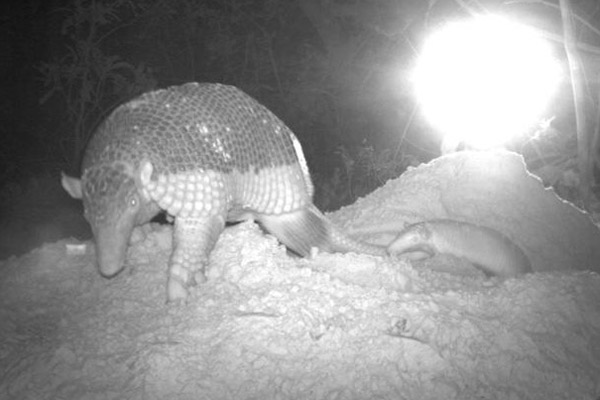
The world’s first ever image of a baby giant armadillo took Runner Up in the New Discoveries category. Photo by: by Arnaud Desbiez/Pantanal Giant Armadillo Project, Brazil.
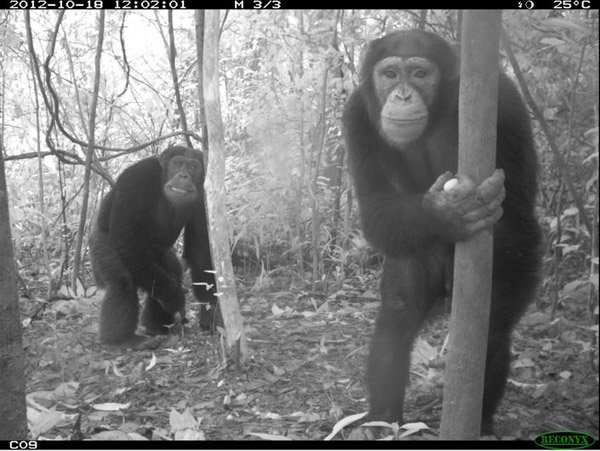
Cheeky chimpanzees in Sierra Leone received a ‘commended’ in the Animal Portraits. Photo by: Nicolas Tubbs/ARTP and GRNP, Sierra Leone.

A leaping brown greater galago received a ‘commended’ in the Animal Behavior. Photo by: Nobesuthu Ngwenya/African Wildlife Conservation Fund, Zimbabwe.
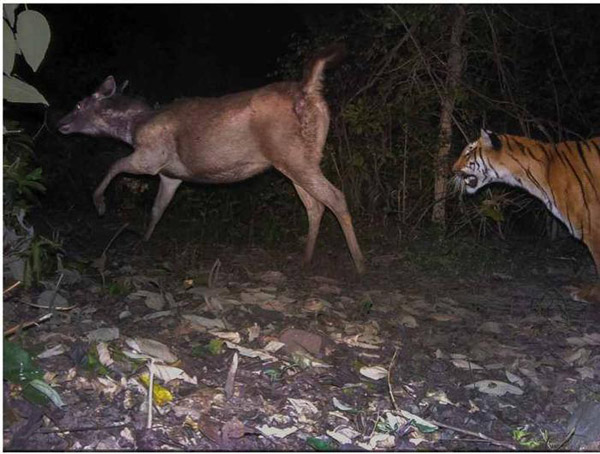
An astounding image of a tiger in pursuit of a sambar deer in India wins Runner Up for Animal Behavior. Photo by: by Bivash Pandav/Ecology of Large Mammals in Shivalik Terai Landscape, Wildlife Institute of India.
Related articles
Camera traps reveal Amur leopards are breeding in China (photos)
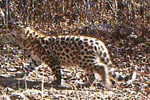
(11/26/2013) Good news today about one of the world’s rarest mammals today: camera traps in China’s Wangqing Nature Reserve have captured the first proof of breeding Amur leopards in the country, according to the Wildlife Conservation Society (WCS). The photos show a mother Amur leopard with two cubs. A recent survey by WWF-Russia estimated the total wild population of Amur leopards at just 50 individuals, but that’s a population on the rise (from a possible nadir of 25) and expanding into long-unused territory.

(11/21/2013) Oil, gas, timber, gold: the Amazon rainforest is rich in resources, and their exploitation is booming. As resource extraction increases, so does the development of access roads and pipelines. These carve their way through previously intact forest, thereby interrupting the myriad pathways of the species that live there. For species that depend on the rainforest canopy, this can be particularly problematic.
Asia’s ‘unicorn’ photographed in Vietnam
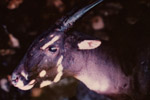
(11/12/2013) In 1992, scientists made a spectacular discovery: a large, land mammal (200 pounds) that had somehow eluded science even as humans visited the moon and split the atom. Its discoverers, with WWF and Vietnam’s Ministry of Forestry, dubbed the species the saola (Pseudoryx nghetinhensis). Found in the Annamite Mountains in Laos and Vietnam, the saola is a two-horned beautiful bovine that resembles an African antelope and, given its rarity, has been called the Asian unicorn. Since its discovery, scientists have managed to take photos via camera trap of a wild saola (in 1999) and even briefly studied live specimens brought into villages in Laos before they died (in 1996 and again in 2010), however the constant fear of extinction loomed over efforts to save the species. But WWF has announced good news today: a camera trap has taken photos of a saola in an unnamed protected area in Vietnam, the first documentation of the animal in the country in 15 years.
Could camera trap videos galvanize the world to protect Yasuni from oil drilling?

(11/07/2013) Even ten years ago it would have been impossible to imagine: clear-as-day footage of a jaguar plodding through the impenetrable Amazon, or a bicolored-spined porcupine balancing on a branch, or a troop of spider monkeys feeding at a clay lick, or a band of little coatis racing one-by-one from the dense foliage. These are things that even researchers who have spent a lifetime in the Amazon may never see. Now anyone can: scientists at the Tiputini Biodiversity Station in Ecuador’s Yasuní National Park have recently begun using camera trap videos to take movies of animals few will ever view in their lifetimes. The videos—following years of photo camera trapping—provide an intimate view of a world increasingly threatened by the oil industry.
World’s most cryptic feline photographed in logging concession

(11/04/2013) The bay cat is arguably the world’s least-known member of the cat family (Felidae). Although first described by scientists in 1874, no photo existed of a living specimen until 1998 and a wild cat in its rainforest habitat wasn’t photographed until five years later. Given this, scientists with Zoological Society of London (ZSL) and Imperial College London were taken aback when their remote camera traps captured numerous photos of these elusive cats hanging out in a commercial logging concession in Sabah, a state in Malaysian Borneo.
Armored giant turns out to be vital ecosystem engineer
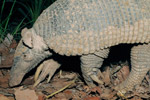
(10/24/2013) The giant armadillo (Priodontes maximus) is not called a giant for nothing: it weighs as much as a large dog and grows longer than the world’s biggest tortoise. However, despite its gigantism, many people in its range—from the Amazon to the Pantanal—don’t even know it exists or believe it to be more mythology than reality. This is a rare megafauna that has long eluded not only scientific study, but even basic human attention. However, undertaking the world’s first long-term study of giant armadillos has allowed intrepid biologist, Arnaud Desbiez, to uncovered a wealth of new information about these cryptic creatures. Not only has Desbiez documented giant armadillo reproduction for the first time, but has also discovered that these gentle giants create vital habitats for a variety of other species.
Featured video: bears work together to take down camera traps
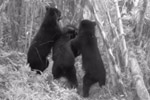
(10/24/2013) Scientists with the Wildlife Conservation Society (WCS) have captured stunning images of Andean bear families taking down camera traps in Bolivia’s Apolobamba National Natural Area of Integrated Management. In one series of images a mother and her two cubs bite, claw, and whack one of the cameras. However even as they destroy one camera, the bears’ antics are captured by another as researchers typically set several cameras to capture different views of animals, a process that helps them identify individuals.
Honey badgers and more: camera traps reveal wealth of small carnivores in Gabon (photos)
.150.jpg)
(10/17/2013) Gabon has lost most of its big meat-eaters including lions, spotted hyenas, and African wild dogs (although it’s still home to leopards), but a new study focuses on the country’s lesser-known species with an appetite for flesh. For the first time, researchers surveyed Gabon’s small carnivores, including 12 species from the honey badger (Mellivora capensis) to the marsh mongoose (Atilax paludinosus).